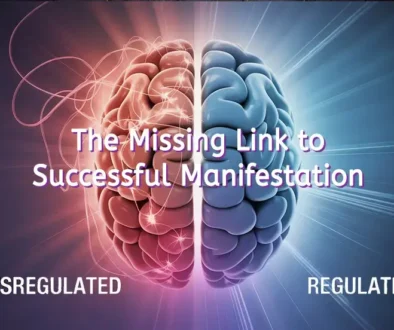How to Stop Overthinking to Manifest Your Dreams: The Science-Backed Guide
You’ve set your intentions. You’ve created the vision board. You’ve done all the “right” manifestation techniques. So why aren’t your desires materializing? Here’s a truth bomb: Overthinking is the silent killer of manifestation. But don’t worry, because today you’ll learn how to stop overthinking to manifest your goals!
Table of Contents:
I’ve seen it countless times in my coaching practice.
A client comes to me frustrated because despite their best efforts, they can’t seem to manifest their desires.
When we dig deeper, we discover the same culprit again and again:
Their mind is spinning with doubt, second-guessing, and endless analysis.
As one client told me, “It’s like I’m driving with one foot on the gas and one foot on the brake.”
That’s exactly what overthinking does to your manifestation power.
The Overthinking-Manifestation Paradox
Manifestation requires clear intention coupled with aligned energy.
But when you overthink, you create a vibrational mismatch that blocks the very things you’re trying to attract.
Let’s break down why this happens and exactly how to stop overthinking.
Why Your Brain Gets Stuck in Overthinking Loops: Negative Thoughts, Worry and Rumination
First, let’s understand what’s happening in your brain when you overthink.
This isn’t just “thinking too much” – it’s a specific pattern that research has identified.
It’s often characterized by automatic negative thoughts.
Overthinking typically shows up in two forms:
- Ruminating – repeatedly dwelling on past events or problems
- Worry – excessively focusing on potential future threats or negative outcomes
Both forms activate your brain’s default mode network (DMN), particularly the prefrontal cortex, which becomes hyperactive during overthinking episodes.
This creates neural pathways that strengthen with repeated use – literally carving worry grooves into your brain.
The impact is staggering.
Research shows the following effects of overthinking:
- Immobilizes 57% of women and 43% of men
- Contributes to a 90% failure rate in achieving ambitious goals
- Reduces motivation by 0.21 points (on a 5-point scale) after failed goals
- Makes you 88.9% more likely to choose easier tasks after setbacks
What Does Overthinking Do to Your Brain?
Chronic overthinking creates overactive neural pathways in your prefrontal cortex.
It’s essentially training your brain to default to worry and rumination.
This pattern disrupts brain chemistry:
It increases stress hormones while reducing serotonin and dopamine levels, which explains why overthinking leads to anxiety and unhelpful thoughts.
Over time, these neural patterns can actually change your brain structure!
This makes it physically more difficult to maintain a positive mindset.
It is more than a mental problem – it’s a manifestation blockade.
The Neurological Clash Between Overthinking and Manifestation
When you understand the science, the conflict between overthinking and manifestation becomes crystal clear.
Effective manifestation usually operates from alpha or theta brainwave states.
The alpha state is relaxed alertness, where your subconscious mind is very receptive.
This state is characterized by:
- Brain waves oscillating at 8-12 Hz
- Reduced stress hormones
- Increased coherence between heart and brain
- Greater receptivity to new beliefs and patterns
Overthinking, however, locks you into beta or high beta states (13-38 Hz), associated with:
- Analytical thinking
- Critical judgment
- Stress hormone production
- Resistance to new patterns and beliefs
Can you see the mismatch?
You cannot access manifestation states while overthinking.
It’s like trying to tune into a radio station while deliberately staying on a different frequency. No matter how hard you try, you’ll only hear static.

The Three Ways Overthinking Sabotages Your Manifestations
Understanding precisely how overthinking blocks your manifestations will help you recognize and overcome these patterns.
1. Creating Resistance Through Doubt and Fear
When you set an intention to manifest something but then immediately question whether it’s possible, you create energetic resistance.
This is the classic example of “I want this, but…” thinking:
- I want financial abundance, but I don’t see how it’s possible.
- I want a loving relationship, but all the good ones are taken.
- I want better health, but maybe it’s too late for me.
Each “but” negates the intention that preceded it.
As Neville Goddard teaches, your manifestation power lies in assuming the feeling of your wish fulfilled. Overthinking prevents you from holding that feeling consistently.
2. Splitting Your Energy Between Wanting and Worrying
Manifestation requires focused energy.
Think of it like watering a garden. If you spray water everywhere, nothing gets enough to flourish.
Similarly, when your mental energy is split between desire and worry, neither gets enough power to materialize.
One client came to me frustrated that she couldn’t manifest her dream job.
When we examined her thought patterns, we discovered she was spending around 10% of her mental energy visualizing success.
Guess where the 90% went?
On worrying about rejection.
No wonder she wasn’t seeing results!
3. Keeping You Anchored to Past Patterns Instead of Future Possibilities
Your manifestations flow from your self-concept – your deep beliefs about who you are and what’s possible for you.
Overthinking keeps you locked in your past-based identity rather than the expanded identity of your future self.
This is especially true if you failed to manifest your goals in your past, which can even worsen your habit of overthinking, according to research.
You remain energetically aligned with what you’ve always had rather than what you’re trying to create.
As I often tell my clients:
You can’t step into a new reality while clinging to an old identity.
How to Identify Your Overthinking Patterns
Before you can overcome overthinking, you need to recognize your personal patterns.
Ask yourself:
- Do I replay past events, analyzing what I could have done differently?
- Do I constantly anticipate worst-case scenarios?
- Do I find it hard to make decisions without excessive research or input?
- Do I often feel mentally exhausted but unable to “turn off” my thoughts?
- Does my thinking tend to spiral, with one worry leading to another?
If you answered yes to any of these, you’ve identified potential overthinking patterns that may be blocking your manifestations.
Science-Backed Techniques to Stop Overthinking, Meditation, and Mindfulness
Now let’s turn to practical solutions backed by research.
These techniques are specifically chosen to break overthinking patterns while enhancing your manifestation power.
Mindfulness and meditation serve as the foundation for many effective overthinking interventions.
By training your brain to focus on the present moment without judgment, you can significantly reduce rumination and worry.
Research shows that mindfulness practices can actually change brain structure, reducing activity in areas associated with overthinking while strengthening regions linked to attention and emotional regulation.
1. Metacognitive Therapy: The Most Effective Approach
What I love about metacognitive therapy is that it focuses on changing your relationship with thoughts.
Not on analyzing their content.
Research shows it has a remarkable 74% recovery rate – outperforming traditional cognitive behavioral therapy (52% recovery) for overthinking-related issues.
Try this metacognitive exercise:
- Notice when you’re overthinking
- Label it. E.g., “I’m having anxious thoughts.”
- Remind yourself: “Thoughts are mental events, not facts.”
- Allow the thoughts to be present without engaging with them
- Gently return your focus to the present moment
This approach teaches your brain that not every thought deserves attention.
With practice, the overthinking habit weakens significantly.
2. Cognitive Defusion: Creating Mental Space
Cognitive defusion techniques help you detach from intrusive thoughts by creating psychological distance. Think of it as stepping back to observe your thoughts rather than being immersed in them.
The Name Your Mind Technique:
- When you catch yourself overthinking, give your mind a nickname (e.g., “The Worrier,” “The Critic”)
- When overthinking starts, say: “Oh, there goes [nickname] again.”
- Thank your mind: “Thanks for sharing that thought.”
- Choose where to place your attention next
This technique has been shown to reduce overthinking symptoms like insomnia and anxiety in multiple studies. By creating space between you and your thoughts, you weaken their grip on your emotional state.
3. The STOP Technique for Immediate Relief
When you’re caught in an overthinking spiral, the STOP technique can provide immediate relief and return you to a manifestation-friendly state:
S – Stop what you’re doing
T – Take a breath
O – Observe your thoughts and feelings without judgment
P – Proceed with intention
Research with high school students found this technique increased mindfulness scores by 10%, enhancing present-moment focus. The beauty of this is its simplicity – you can use it anywhere, anytime overthinking strikes.
4. Structured Action Plans: From Thinking to Doing
One of the most effective ways to break overthinking is to shift from passive worry to active problem-solving. This approach is particularly effective for manifestation work because it aligns your actions with your intentions.
Try this three-step approach:
- Schedule a dedicated 20-minute “worry time” (daily if needed).
- Transform vague concerns into specific, actionable steps.
- Set decision-making time limits to prevent analysis paralysis.
Studies show this method breaks the rumination cycle by prioritizing problem-solving over passive worry.
The process of letting go becomes easier when you have a structured system for handling concerns. It assures your brain that nothing important will be forgotten or overlooked.
5. Physiological Regulation: Calming Your Nervous System
Your body and mind are intimately connected. By regulating your physiology, you can directly impact your thought patterns and create a more receptive state for manifestation.
The 4-7-8 Breathing Technique:
- Inhale quietly through your nose for 4 seconds
- Hold your breath for 7 seconds
- Exhale completely through your mouth for 8 seconds
- Repeat 3-4 times
This technique activates your parasympathetic nervous system and has been shown to reduce stress hormones within minutes. While it provides immediate relief, it works best when combined with the cognitive approaches above for lasting change.
Manifestation-Specific Techniques for Overthinkers
Now that we’ve covered general overthinking remedies, let’s explore techniques specifically designed for manifestation work.
Embodiment Practices: Feeling Before Seeing
A common manifestation mistake is trying to think your way to results.
True manifestation happens through embodiment – feeling the reality you desire as if it’s already present.
The Manifestation Embodiment Process:
- Create a quiet, uninterrupted space
- Close your eyes and take several deep breaths
- Bring to mind your desired manifestation
- Ask: “How would I feel if this were already my reality?”
- Allow those feelings to permeate your body completely
- Stay with this embodied feeling for 5-10 minutes
- Throughout your day, recall and reconnect with this feeling state
Embodiment bypasses overthinking by anchoring your manifestation in sensation rather than thought.
This is powerful because your subconscious mind responds more strongly to felt experience than to intellectual concepts.
Future Self Journaling for Analytical Minds
If you have an analytical mind, journaling can be a constructive channel for your thinking energy. Future self journaling is particularly effective for manifestation work.
How to Practice Future Self Journaling:
- Date your entry 6-12 months in the future
- Write in present tense as if your manifestation has already occurred
- Include sensory details and emotional states
- Describe how this manifestation unfolded naturally
- Express gratitude for this new reality
This practice gives your analytical mind something constructive to do while programming your subconscious for manifestation success.
Studies show that consistent journaling can significantly reduce rumination while strengthening your connection to your desired future.
The “5-4-3-2-1” Grounding Method for Manifestation
When overthinking pulls you out of the present moment, use this sensory grounding technique with a manifestation twist:
- Notice 5 things you can see (visualize one of them transforming to reflect your manifestation)
- Notice 4 things you can touch (imagine one has the texture of what you’re manifesting)
- Notice 3 things you can hear (envision hearing news related to your manifestation)
- Notice 2 things you can smell (associate one with the achievement of your desire)
- Notice 1 thing you can taste (connect it to the sweetness of your manifestation fulfilled)
This technique interrupts rumination by redirecting attention to sensory experiences while subtly reinforcing your manifestation work.
It’s particularly helpful during acute overthinking episodes.
How to Stop Overthinking: Creating a Manifestation-Friendly Mental Environment
Stopping overthinking isn’t just about techniques – it’s about creating a mental environment where manifestation can flourish naturally.
Regular Mental Decluttering
Just as you would declutter your physical space, regular mental decluttering is essential for manifestation clarity.
Try this weekly mental decluttering practice:
- Set aside 20-30 minutes in a quiet space
- Write down all your current mental preoccupations
- For each item, decide: Can I act on this now? Can I schedule it? Can I let it go?
- Take immediate action on quick items
- Schedule time for important matters
- Consciously release what doesn’t serve you
This practice prevents the accumulation of mental debris that fuels overthinking and blocks clear manifestation.
Creating Environmental Triggers for Present-Moment Awareness
Your physical environment can either support or undermine your efforts to stop overthinking and enhance manifestation.
Set up environmental reminders:
- Place colored stickers on items you use frequently – when you see them, take a breath and reconnect with the present
- Set random phone reminders with messages like “Come back to now” or “Feel your manifestation”
- Create a dedicated manifestation space in your home that’s free from work, bills, or other stress triggers
These environmental cues interrupt unconscious overthinking patterns and remind you to return to manifestation-conducive states.
The Power of Nervous System Regulation
Your nervous system state directly impacts your receptivity to manifestation.
Regulating your nervous system is crucial for reducing overthinking and creating the inner conditions for manifestation.
Signs of a dysregulated nervous system that promotes overthinking include:
- Racing thoughts
- Difficulty concentrating
- Sleep disturbances
- Digestive issues
- Chronic tension
Regular practices like meditation, yoga, time in nature, and breathwork help regulate your nervous system, creating the calm, receptive state where manifestation thrives.
Self-Concept Work: The Ultimate Overthinking Solution
At the deepest level, overthinking often stems from a shaky self-concept – your fundamental beliefs about who you are and what you deserve.
When you strengthen your self-concept, overthinking naturally diminishes because there’s less internal conflict between your desires and your sense of self.
Core self-concept work includes:
- Identifying and challenging limiting beliefs about your worth and capabilities
- Consciously choosing empowering beliefs that align with your desired reality
- Regular affirmation and visualization of your expanded self-concept
- Acting in alignment with your desired self-concept, even when it feels uncomfortable
As your self-concept transforms, the frequency and intensity of worrying and ruminating decrease naturally.
Your manifestations begin flowing more easily because there’s less internal resistance.
How to Stop Overthinking: Success Story
I had a client who was a chronic overthinker.
Financial anxiety caused her to overthink every money decision, blocking her abundance manifestations.
Using embodiment practices and a structured action plan we created just for her, she created a new relationship with money.
She subsequently manifested unexpected income streams that doubled her revenue within a year.
I see these transformations regularly in my practice, and they all follow the same pattern:
As overthinking decreases, manifestation power increases.
When to Seek Professional Support
These techniques are powerful, but sometimes professional support is necessary. Consider working with a coach or therapist if:
- Your overthinking causes significant distress or impairment
- You experience persistent insomnia or physical symptoms
- You’ve tried self-help approaches without success
- Your overthinking involves traumatic experiences
- You notice signs of anxiety or depression alongside overthinking
Professional guidance can accelerate your progress and provide personalized strategies for your specific thought patterns.
For those with an anxiety disorder, professional treatment combining CBT and mindfulness approaches has shown particularly strong outcomes.
As someone certified in Cognitive Behavioral Therapy (CBT), I’ve seen firsthand how these approaches can transform thought patterns.
Your Action Plan to Stop Overthinking
To maximize your results, I recommend an integrated approach that combines these techniques:
Daily Practice (10-15 minutes):
- 5 minutes of breathwork or meditation
- 5 minutes of embodiment practice for your current manifestation
- 5 minutes of future self journaling
In-the-Moment Interventions:
- Use the STOP technique when you catch yourself overthinking
- Apply cognitive defusion to create space from intrusive thoughts
- Use the 5-4-3-2-1 grounding method during intense overthinking episodes
Weekly Practice (30-60 minutes):
- Mental decluttering session
- Review and adjustment of your manifestation practices
- Self-concept reinforcement work
Monthly Review:
- Assess your overthinking patterns and note improvements
- Celebrate manifestation progress
- Adjust your approach based on what’s working
Remember, consistency is key. Overcoming limiting beliefs and thought patterns requires regular practice, but the rewards are immense.
How to Stop Overthinking to Manifest Your Dreams: Bottom Line
There you have it – your complete guide on how to stop overthinking!
Cycles of overthinking don’t have to be your permanent reality.
With these science-backed approaches, you can break free from mental loops and unlock your true manifestation potential.
- As research confirms, metacognitive approaches and structured action plans show the highest effectiveness for long-term change.
- Physiological regulation provides immediate relief.
- Self-concept work addresses the root causes of overthinking.
By integrating these approaches, you create a powerful system for mental freedom and manifestation success.
I’ve seen many people transform their overthinking into clarity and their blocked manifestations into beautiful realities.
The same is possible for you.
Remember:
A quiet mind is your most powerful manifestation tool.





